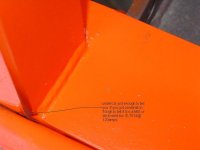accordionman
Gold Member
JIM,
have you tried 7014 in 3/32 rod? this is what i use all the time for
any stick welding. i have some 1/8 rod in 7014, but it seems to me, the
smaller diameter just runs better. i know, it will take longer because of the
smaller diameter, but it seems the smaller diameter "fits" into places that a larger
rod will not. on this rod, you have to hold a very short arc. have you tried the
"drag" rods? i think anyone starting in welding should try those, at some point.
good luck with your projects.
accordionman
william l. brown
wright city, mo.
have you tried 7014 in 3/32 rod? this is what i use all the time for
any stick welding. i have some 1/8 rod in 7014, but it seems to me, the
smaller diameter just runs better. i know, it will take longer because of the
smaller diameter, but it seems the smaller diameter "fits" into places that a larger
rod will not. on this rod, you have to hold a very short arc. have you tried the
"drag" rods? i think anyone starting in welding should try those, at some point.
good luck with your projects.
accordionman
william l. brown
wright city, mo.
